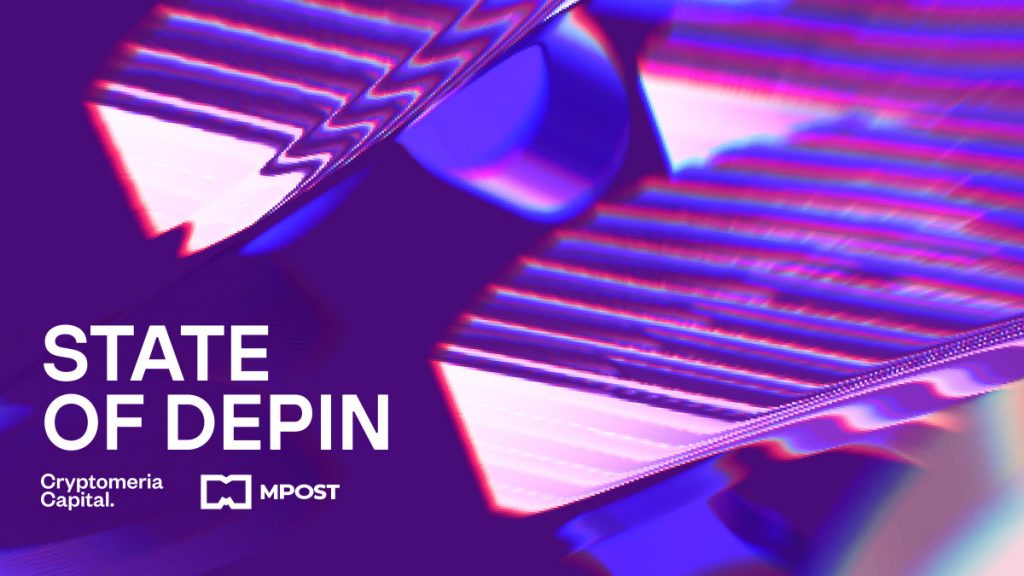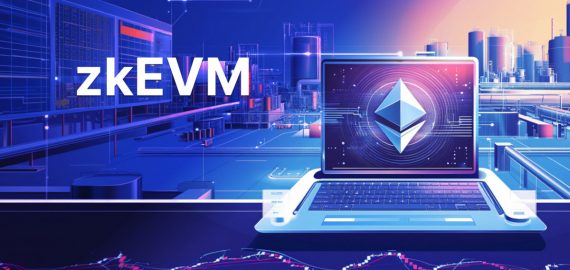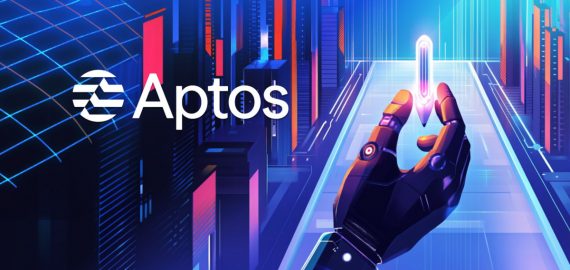State of DePIN 2024 Report Reveals Key Insights From Decentralized Physical Infrastructure Networks Landscape


In Brief
Efficiency, equity and forthcoming DePIN developments take center stage in Cryptomeria Capital’s latest State of DePIN 2024 Report.

Delving into the evolving realm of Decentralized Physical Infrastructure Networks (DePIN), Cryptomeria Capital, in collaboration with MPost, published a comprehensive report, “State of DePIN 2024”. This report highlights the pivotal significance of the interconnected physical infrastructures for extending decentralization beyond the digital sphere into the physical domain. So, a new era of infrastructure development characterized by increased efficiency, equity, and community engagement is coming.
Discover some of the compelling insights:
- DePIN emerges as 2024’s most promising market, endorsed by top venture funds;
- This segment has a great chance to soar up to $3.5 trillion within four years;
- An overwhelming number of businesses (95%) now take multi-cloud strategies as a priority. It shows the crucial role of information security in business models nowadays;
- AI boosts digital infrastructure and network capabilities, sustaining high demand into 2024;
- Solutions like the zkSync Era Boojum update have significantly lowered transaction costs via optimized data handling.
That’s not all! The report provides significant insights from the DePIN sector, offering an overview of its infrastructure and an ecosystem map featuring a multitude of projects spanning various domains such as data storage, cloud computing, wireless and sensor networks. Moreover, it shows the peculiarities of integration with DePIN with AI and ZK technologies and sheds light on the forthcoming developments in the DePIN landscape, which appeal equally to both individuals and organizations.
For a complete overview of the DePIN landscape, you can see the complete report right here.
While the real-world economy boasts a valuation in the hundreds of trillions of dollars, the current total addressable market for the DePIN sector stands at approximately $2.2 trillion, indicating a potential surge to $3.5 trillion by 2028. By utilizing blockchain technology, token incentives, and Internet capabilities, DePIN initiatives are poised to tackle some of society’s most fundamental challenges.
“DePIN protocols have the potential to empower individuals and smaller entities, enabling them to engage, transact, and even compete against established centralized infrastructure giants,” said Vadim Krekotin, Founding Partner at Cryptomeria Capital. “This shift signifies a departure from monopolistic and centralized control toward a more democratized and distributed model, promising enhanced access, flexibility, and transparency for users globally,” he also added.
A wide range of companies were analyzed in the report, among them were Filecoin, Arweave, Storj, Sia, BNB Greenfield, Zus, Oort, 4EVERLAND, CESS (Cumulus Encrypted Storage System), Glacier Network, Render, Theta, Akash, Holochain, Livepeer, Golem, Io.Net, Dynex, Gensyn, Web3mine, Helium, Althea, Wayru Network, FOAM, WiFi Map, Andrena, Drop Wireless, Chirp, Grass, Meson Network, Hivemapper, DIMO, WeatherXM, NATIX Network, GEODNET, Silencio, Soarchain, Spexigon, Drife, Arkreen Network, zkSync Era, Scroll, Starknet, Polygon zkEVM, Manta Network. The report’s media partners include MPost and Hack Seasons.
Witness the Potential of DePIN Firsthand: What Should You Expect to See in the Report?
The DePIN market has a rich history, tracing back to the establishment of pioneering networks like Filecoin and Storj in 2014. Since then, numerous services and solutions have emerged, serving thousands of users and generating substantial revenue. Conceptually aligned with traditional blockchain models, DePINs foster communities, enable resource monetization, facilitate validation and governance decisions, and store on-chain data to enhance user functionality.
Amid monopolies dominating sectors such as wireless and sensor networks, computing, and storage Infrastructure, DePIN emerges as a viable alternative for startups and users seeking cost-effective and reliable options. The centralized nature of these sectors has led to inherent limitations, prompting the need for decentralized solutions backed by blockchain technology and clear rules of engagement.
“DePINs can revolutionize industries by transitioning them to decentralized infrastructures. Beyond democratizing access to critical data and operations, it can reduce expenses, enhance efficiency, and foster scalability,” said Alex Mukhin, Co-founder and Managing Partner at Cryptomeria Capital.” Furthermore, by eliminating entry barriers, DePINs stimulate innovation across various sectors. For instance, with DePINs, there’s potential for the emergence of decentralized equivalents to Uber or Airbnb and democratic alternatives to platforms like ChatGPT, which are fueled and owned by their contributors.”
While the DePIN market remains in its nascent phase, the potential of DePINs is vast. Driven by the emergence of revenue-generating projects and consumer interest, this burgeoning sector offers a promising opportunity for exploration and development. Cryptomeria Capital’s comprehensive report provides a detailed snapshot of the evolving landscape of DePIN, shedding light on the pivotal advancements and challenges shaping the future of this dynamic field.
Take a Look at the Companies From the Heart of the DePIN Report:
- Filecoin is a decentralized storage network that transforms cloud storage into a system based on algorithms.
- Arweave is a decentralized blockchain platform that offers permanent data storage and retrieval, ensuring security against unauthorized access.
- Storj is a blockchain platform powering a decentralized system for digital file storage.
- Sia is a decentralized cloud storage network that combines a Proof-of-Work blockchain with a contract-based storage model.
- BNB Greenfield is a blockchain positioned to be the pivotal Data Availability (DA) layer for opBNB, aiming to reduce opBNB gas prices to ten times cheaper.
- Zus (formerly 0Chain) offers a decentralized, high-performance multi-cloud storage solution emphasizing strong security and freedom from vendor lock-in.
- Oort (formerly Computecoin Network) is a decentralized cloud technology, leveraging the Proof-of-Honesty (PoH) consensus and ZKP to offer a storage and Web3 hosting solution that emphasizes privacy and cost-efficiency.
- 4EVERLAND is a Web3 cloud multi-platform for storage and computing, with RaaS and network capabilities.
- CESS (Cumulus Encrypted Storage System) is a blockchain-powered decentralized storage and content delivery network (CDN) designed specifically for Web3.
- Glacier Network is a Layer 2 data network designed to improve DApps’ utilization of decentralized databases (DDB) with ZKP implementation.
- Render is a decentralized platform leveraging blockchain technology, which positions itself as a provider of distributed GPU rendering services.
- Theta is a decentralized video streaming service.
- Akash is a decentralized cloud computing platform anchored by a blockchain-based marketplace.
- Holochain is a distributed platform for hosting peer-to-peer applications.
- Livepeer is a decentralized video streaming network built on blockchain technology.
- Golem is a peer-to-peer platform that facilitates the decentralized sharing and leasing of computing resources.
- Io.Net is a decentralized computing network providing affordable access to distributed cloud clusters for machine learning engineers.
- Dynex is a decentralized supercomputing network architecture based on neuromorphic computing, which mimics the human brain’s neural structure, offering efficient parallel processing capabilities.
- Gensyn is a decentralized machine learning computing network aiming to reshape the landscape of AI development by uniting the world’s computational resources into a global supercluster.
- Web3mine is building an open-access computing network to democratize the creation and capture of value in new or established decentralized networks.
- Helium is a network created by Nova Labs, initially built on its own blockchain and later migrated to the Solana network, connecting IoT devices.
- Althea is a specialized settlement layer designed for infrastructure and connectivity, offering high availability and reliability.
- Wayru Network is a decentralized internet network aimed at bridging the digital divide.
- FOAM is a lack of standardized location encoding in the realm of smart contracts and blockchain-based projects.
- WiFi Map is a platform of services aimed at increasing the availability of WiFi networks, improving internet connection accessibility and security, and informing people about accessible WiFi access points.
- Andrena is a US-focused wireless internet company dedicated to transforming web accessibility.
- Drop Wireless is a project positioned to upgrade the telecommunications industry in the era of 5G and the Internet of Things.
- Chirp is creating the robust and seamless DePIN blockchain by leveraging decentralization, connecting a vast number of devices through a radio-agnostic approach, and addressing the complexities in IoT, mobile, and broadband internet connectivity.
- Grass (Wynd Network) is a network created by Wynd Network that allows users to monetize their unused internet bandwidth by selling it to corporations and institutions.
- Meson Network is an infrastructure layer and future marketplace for DePIN based on the native blockchain.
- Hivemapper is a mapping and navigation platform that utilizes crowdsourced data to create detailed, up-to-date maps.
- DIMO is a decentralized network that connects vehicles and aggregates automotive data.
- WeatherXM is pioneering a new weather data economy by incentivizing the deployment and maintenance of weather stations through WXM token rewards.
- NATIX Network is a decentralized network designed to facilitate data collection, sharing, and utilization across various sectors.
- GEODNET is a technical infrastructure to collect, analyze, and share earth observation data.
- Silencio utilizes IoT devices and mobile applications for real-time noise pollution monitoring, relying on community contributions to collect data across various locations.
- Soarchain is a platform designed for the mobility sector, utilizing blockchain and cellular-V2X technologies to facilitate a decentralized data and identity infrastructure.
- Spexigon is a “Fly-to-Earn” drone imagery platform that incentivizes drone operators to capture and share high-resolution aerial images.
- Drife is a decentralized ride-hailing platform that leverages blockchain technology to create a peer-to-peer network for drivers and riders.
- Arkreen Network is a digital infrastructure initiative to integrate and monetize globally distributed renewable energy resources.
- zkSync Era is a Layer-2 protocol that scales Ethereum with cutting-edge ZK tech.
- Scroll is the community-first, native zkEVM built upon Ethereum, which is designed for scaling without sacrificing security, developer, or user experience. You can check out an interview with Scroll.
- Starknet is a decentralized layer-2 network that enables Ethereum to scale securely and dApps to achieve unlimited scale for transactions and computation.
- Polygon zkEVM is a scaling solution constructed by Polygon that enables Ethereum transactions to be faster, more secure, and cheaper.
- Manta Pacific is the first EVM-equivalent ZK-application platform that is scalable and secure through Celestia DA and Polygon zkEVM. Take a look at an interview with Manta.
Disclaimer
In line with the Trust Project guidelines, please note that the information provided on this page is not intended to be and should not be interpreted as legal, tax, investment, financial, or any other form of advice. It is important to only invest what you can afford to lose and to seek independent financial advice if you have any doubts. For further information, we suggest referring to the terms and conditions as well as the help and support pages provided by the issuer or advertiser. MetaversePost is committed to accurate, unbiased reporting, but market conditions are subject to change without notice.
About The Author
Alisa, a dedicated journalist at the MPost, specializes in cryptocurrency, zero-knowledge proofs, investments, and the expansive realm of Web3. With a keen eye for emerging trends and technologies, she delivers comprehensive coverage to inform and engage readers in the ever-evolving landscape of digital finance.
More articles

Alisa, a dedicated journalist at the MPost, specializes in cryptocurrency, zero-knowledge proofs, investments, and the expansive realm of Web3. With a keen eye for emerging trends and technologies, she delivers comprehensive coverage to inform and engage readers in the ever-evolving landscape of digital finance.


















































